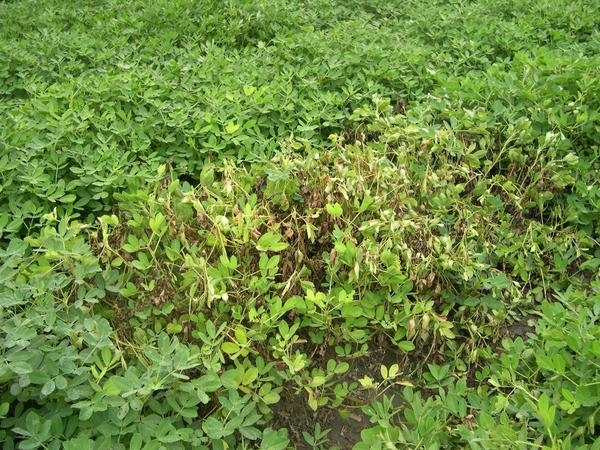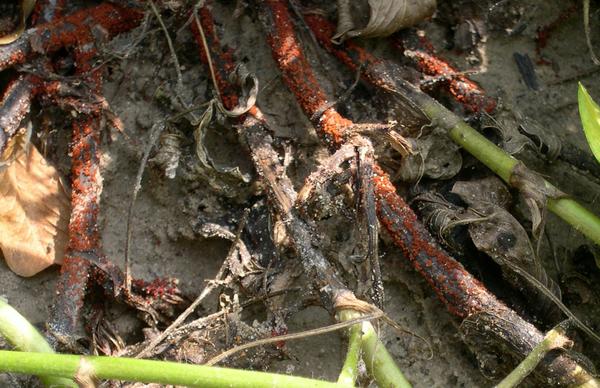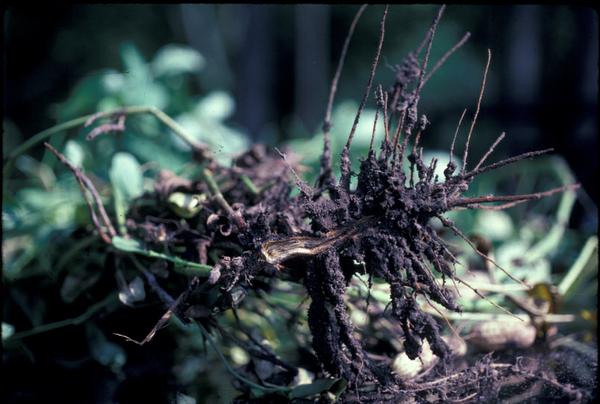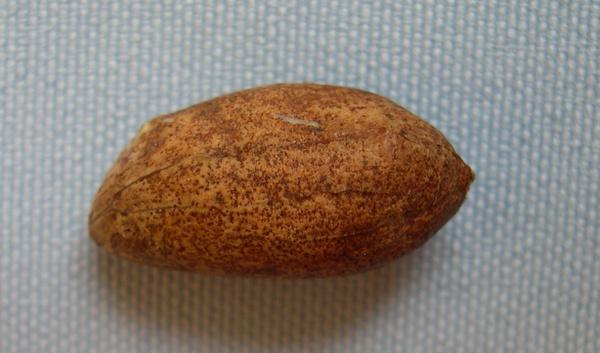General Information
Cylindrocladium black rot (CBR) is a severe root disease in peanut caused by the soil borne fungus Cylindrocladium parasiticum (also known as Calonectria ilicicola). CBR is present in all peanut production areas in North Carolina, but it is most common in fields that have a long history of peanut production. Without proper management, this disease has a history of causing devastating yield losses in North Carolina. CBR losses have become rare in North Carolina for a combination of known (better rotations and resistant cultivars) and unknown reasons. However, growers are cautioned to take steps to prevent CBR problems due to the very high damage potential of this disease.
Symptoms, Signs, and Diagnosis
Wilting on hot afternoons in mid-summer is usually the first symptom of disease. Later, the entire plant turns light green or yellow and may die. Dead and wilted plants tend to occur in clusters (Figure 1). Late in the season, particularly following moist weather, the fungus produces numerous brick-red, pinhead-sized fruiting structures (perithecia) that can be seen on crowns, lower stems, and pods of infected plants (Figure 2).
The taproot of symptomatic plants is black and rotted. Lateral roots have similar symptoms, or may be missing entirely (Figure 3). The rotted roots are very brittle and infected plants often break off at the soil line when tugged. CBR also causes a brittle black rot on pods resulting in heavy yield losses. Seeds that are not rotted often are covered with cinnamon-brown speckles (Figure 4). These are fungal survival structures called microsclerotia.
Symptoms of CBR can be confused with spotted wilt caused by the tomato spotted wilt virus. The presence of brick-red perithecia is diagnostic of CBR, as is the presence of cinnamon-colored microsclerotia on seed coats. Mild root rot may be present with spotted wilt, but roots remain pliable or soft, unlike the brittle roots of plants with CBR. An immunostrip test can be used to diagnose spotted wilt if the cause of wilting or yellowing is in doubt.
Factors That Favor Disease
The CBR fungus is most active in cool, moist soil. Many root infections occur soon after planting when soils are cool. Root wounding from nematode infections increases severity of CBR infection.
Poor rotations are a major source of CBR problems. Peanut, soybean, and other hosts support growth and reproduction of the CBR fungus. Decomposing roots, pods, and seeds release thousands of microsclerotia into the soil, where they can survive for several years and infect peanut or other susceptible hosts.
Disease Cycle
The CBR pathogen survives in soil and on seed as microsclerotia. These cinnamon-brown to dark brown, pin-head sized fungal structures can survive in soil for several years. Host plants come in contact with microsclerotia as their roots grow through infested soil. Root exudates stimulate the microsclerotia to germinate and infect roots. Once inside the plant, the fungus slowly colonizes root tissues, eventually causing a dark, dry rot of the tap- and lateral roots. Above-ground symptoms are not apparent for several weeks after infection. Plants begin to wilt in hot weather due to disruptions in root function. There is only one cycle of infection per year, but disease continues to increases as the roots of the growing plants continue to encounter microsclerotia and become infected. The fungus continues to also colonize roots and to attack and colonize pods and seeds once they are formed. Severely infected plants die before harvest. The fungus may produce distinctive brick-red perithecia on plant crowns, stems, and pods. The perithecia are sexual reproductive structures that contain ascospores. The ascospores are adapted for dispersal in splashing water, but do not appear to play a significant role in disease development or spread. The fungus also begins to produce new microsclerotia in the rotted roots, pods, and crowns, and on seed of diseased plants. Microsclerotia are released into the soil when the diseased tissues break down and will survive there until the next time a susceptible crop is planted.
Cultural Control
Rotations of four years or more to non-hosts are necessary to prevent or reduce CBR problems. Cotton, corn, sorghum, and small grains are not hosts of the CBR fungus and are excellent rotation crops. On the other hand, the CBR fungus infects and reproduces on soybean, making it a poor choice in peanut rotations. The disease on soybean is known as red crown rot. Soybean can be infected without a grower being aware of the problem because symptoms tend to be mild.
Planting a resistant cultivar often is all that is needed to avoid CBR losses in well-rotated fields. The Virginia-type cultivars Bailey and Sullivan and several runner-type cultivars have high partial resistance to CBR. Avoid planting highly susceptible cultivars in fields with a history of CBR. The status of CBR resistance in cultivars released after 2013 is somewhat uncertain because lack of disease in the field has hampered resistance screening.
CBR can be transmitted on infected seed. Seed production should be limited to fields that are disease-free and seed with speckled coats should be culled from seed production lines.
The CBR fungus is most active in cool, moist soils. Planting on a bed helps to promote soil warmth and drainage and will reduce the chances of infection in the spring. Nematode control also is important for reducing CBR damage. Good rotations for CBR prevention have the added benefit of reducing nematode populations in soil.
CBR can be confused with spotted wilt, so be sure to obtain a positive diagnosis if there is any doubt. Make a note of problem fields and attempt to estimate the percentage of plants with symptoms. This information will help with rotation, fumigation, and cultivar choices the next time peanuts are planted.
Chemical Control
Seed treatment fungicides prevent the possibility of seed transmission of CBR. Always plant fungicide-treated seed obtained from a reputable dealer.
Fumigation with metam sodium may be necessary in fields with a history of greater than 10% disease the last time peanuts were planted. Fumigation works by killing the fungus in soil. Root knot and ring nematodes can make CBR problems worse and fumigation also provides some control of these nematodes.
Inject metam sodium 42% at 7.5 gal/acre 12 inches below the top of the bed (or 8 inches below the original soil surface) at least two weeks before planting. Apply after soil temperatures reach 60°F at a 4-inch depth, and temperatures of 60°F or higher are forecast for the next 5 days. Wait to fumigate if an inch or more of rain is forecast within 3 days because rain can greatly diminish the effectiveness of fumigation. Avoid disturbing the soil after fumigation or untreated soil could be mixed with the fumigated soil. Herbicides can be incorporated before bedding and fumigation. Special precautions are required by law when applying soil fumigants. See the soil fumigant toolbox for the latest detailed label requirements and other information.
In-furrow applications of some fungicides can suppress CBR, but these usually are not necessary if a resistant cultivar is planted.
More Information
Publication date: Oct. 30, 2018
Revised: May 21, 2020
N.C. Cooperative Extension prohibits discrimination and harassment regardless of age, color, disability, family and marital status, gender identity, national origin, political beliefs, race, religion, sex (including pregnancy), sexual orientation and veteran status.




